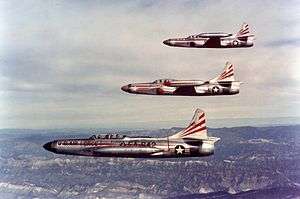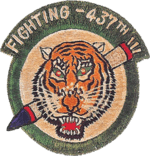Oxnard Air Force Base
Oxnard Air Force Base | |
|---|---|
| Part of Air Defense Command | |
| Camarillo, California | |
|
Convair F-106A-90-CO Delta Dart 57-2486 437th Fighter-Interceptor Squadron. | |
 Oxnard AFB | |
| Coordinates | 34°12′50″N 119°05′40″W / 34.21389°N 119.09444°W |
| Type | Air Force Base |
| Site history | |
| Built | 1940 |
| In use | 1940-1945; 1951-1970 |


Oxnard Air Force Base (1940–1945, 1951–1970) is a former United States Air Force base located in Camarillo, California on the Oxnard Plain approximately 3 miles (4.8 km) west of the historic business district. A fighter training airfield during World War II, it was part of the Air Defense Command, later renamed Aerospace Defense Command, and during the Cold War it was used as a fighter-interceptor base.
History
Origins
Oxnard Airport (not to be confused with the current Oxnard Airport) was opened in 1934 by the County of Ventura and consisted of a 3,500-foot (1,100 m) dirt runway. The first fixed-base operator on the field was Joe Plosser. He owned only two aircraft, but had no housing for them. During the thirties Howard Hughes erected a tent on the airport to shelter his H-1 racer, which he tested from the Oxnard Airport.[1]
The County of Ventura paved the runway in 1938 and a large hangar (now known as Hangar #2) was built by the Works Progress Administration. In 1939 James "Elmo" McLean opened the Oxnard Flying School with two aircraft, a 40 hp J-3 Cub and a Kinner two-seater.[1]
World War II
The U.S. Army Air Corps moved its civilian training program onto the airport in 1940 to establish an Air Corps Flying Training Command contract flying school called Mira Loma Flight Academy. Housing was built across the street for the cadets and instructors. The airfield was first activated on 12 September 1940. The school was one of many in California that trained aviation cadets in primary flying skills, the graduates being reassigned to basic flying schools at regular AAF bases. The airport was originally established when the California State Highway Department constructed an auxiliary landing field with a 5,000 ft (1,500 m) runway.
Along with the contract flying, the IV Fighter Command 383d Fighter Squadron operated P-38 Lightning aircraft from the airport during October and November 1943; the 430th Fighter Squadron during January 1944, and the 435th Fighter Squadron during February and March 1944. These squadrons provided training on high-performance fighters for pilots prior to their deployment to overseas combat theaters.
The contract flying school was inactivated on 27 June 1944. The facility, renamed "Oxnard Flight Strip", was reassigned to Second Air Force on 1 September 1944, with the 29th Fighter Squadron being assigned from Bakersfield Airport. The 29th's mission was a testing unit for P-59 Airacomet and P-80 Shooting Star jet aircraft. Oxnard was closed on 10 July 1945 as part of a consolidation of AAF fields at the end of World War II.
Postwar era
The County of Ventura officially regained control of the airport from the federal government in 1948 by receiving a final quitclaim deed. The State of California issued the airport an operating permit in 1949.[1]
The first scheduled airline flights began in 1946 by Southwest Airlines and later Pacific Airlines, flying Douglas DC-3's and Fokker F-27's respectively.[1]
Cold War


The airfield was reactivated during the Cold War as an Air Defense Command (ADC) base in 1951, and was operated jointly by the USAF and Ventura County as a joint-use facility. The runway was extended to 8,000 ft (2,400 m), and the Air Force ground station was rebuilt in 1951.
Oxnard Air Force Base was assigned to ADC's 27th Air Division, 533d Air Defense Group. Initially part of the Western Air Defense Force, Oxnard was reassigned to the Los Angeles Air Defense Sector in February 1959. Operations began in 1952 with the activation of the 354th Fighter-Interceptor Squadron. Initially equipped with surplus F-51 Mustangs, the squadron received F-94C Starfire jet interceptors in 1953. The 354th FIS remained at Oxnard until 1955 when it was reassigned to McGhee Tyson Airport/McGhee Tyson AFB, near Knoxville, Tennessee to provide air defense for the Oak Ridge National Laboratory.
On 18 August 1955, the 533d ADG was redesignated as the 414th Fighter Group, and the 354th FIS was replaced by the 437th Fighter-Interceptor Squadron, which was reassigned from Otis AFB, Massachusetts. These units would remain at Oxnard until its closure in 1969. Interceptor aircraft flown by the squadron were F-89C Scorpions until 1960, then the F-101B Voodoo. A second squadron, the 66th Fighter-Interceptor Squadron was assigned to Oxnard briefly in late 1957 and early 1958 but was never equipped due to budgetary constraints.
A second ADC Air Defense Group, the 4722d Air Defense Group, a provisional unit, was activated at Oxnard on 1 December 1956. This group controlled two Fighter-Interceptor squadrons at George AFB, near Victorville, California. It inactivated on 25 June 1958, turning over its personnel and equipment to the 414th Fighter Group.
On 18 July 1968 the 437th FIS received 17 new F-106 Delta Darts from the 456th Fighter-Interceptor Squadron, which was moved from Castle AFB, near Merced. The aircraft and personnel of the 456th FIS were reassigned to the 437th FIS, and the 456th was inactivated as part of this consolidation by the now renamed Aerospace Defense Command (ADC). On 30 September 1968, the 437th FIS was discontinued and redesignated as the 460th Fighter-Interceptor Squadron, because the 460th FIS was regarded by ADC of having a more distinguished history.
On 1 January 1970, Oxnard AFB was inactivated as ADC began closing fighter-interceptor bases as the chances of an attack on the United States by hostile bomber aircraft seemed remote. Oxnard AFB had 99 Officers and 990 enlisted assigned prior to its closing. The last commanding officer of the 414th Fighter Group was Colonel Paul D. Cofer.
With its closure, the military facility was deeded to local civil authorities and was incorporated into the present day Camarillo Airport.
See also
| Wikimedia Commons has media related to Oxnard Air Force Base. |
References
![]() This article incorporates public domain material from the Air Force Historical Research Agency website http://www.afhra.af.mil/.
This article incorporates public domain material from the Air Force Historical Research Agency website http://www.afhra.af.mil/.
- 1 2 3 4 "Oxnard Airport History". County of Ventura. Retrieved 27 November 2016.
- Manning, Thomas A. (2005), History of Air Education and Training Command, 1942–2002, Office of History and Research, Air Education and Training Command, Randolph AFB, Texas.
- USAF Aerospace Defense Command publication, The Interceptor, January 1979 (Volume 21, Number 1).
- Maurer, Maurer, ed. (1982) [1969]. Combat Squadrons of the Air Force, World War II (PDF) (reprint ed.). Washington, DC: Office of Air Force History. ISBN 0-405-12194-6. LCCN 70605402. OCLC 72556.
- Shaw, Frederick J. (2004), Locating Air Force Base Sites History’s Legacy, Air Force History and Museums Program, United States Air Force, Washington DC, 2004.
- Oxnard Airport History


